
Birds are remarkable creatures that have captivated humans for centuries with their ability to soar through the skies. Among the over 11,197 bird species worldwide, some stand out for their exceptional speed and agility in flight.
In this article, we’ll explore the top 10 fastest flying birds in the world. We will delve into their unique characteristics and habitats. We’ll also examine the incredible speeds they can achieve.
- Peregrine Falcon (Falco peregrinus)
- Saker Falcon (Falco cherrug)
- Golden Eagle (Aquila chrysaetos)
- Gyrfalcon (Falco rusticolus)
- White-throated Needletail (Hirundapus caudacutus)
- Common Swift (Apus apus)
- Eurasian Hobby (Falco subbuteo)
- Magnificent Frigatebird (Fregata magnificens)
- Spur-winged Goose (Plectropterus gambensis)
- Red-breasted Merganser (Mergus serrator)
Let us see one by one in detail way.
1. Peregrine Falcon (Falco peregrinus)
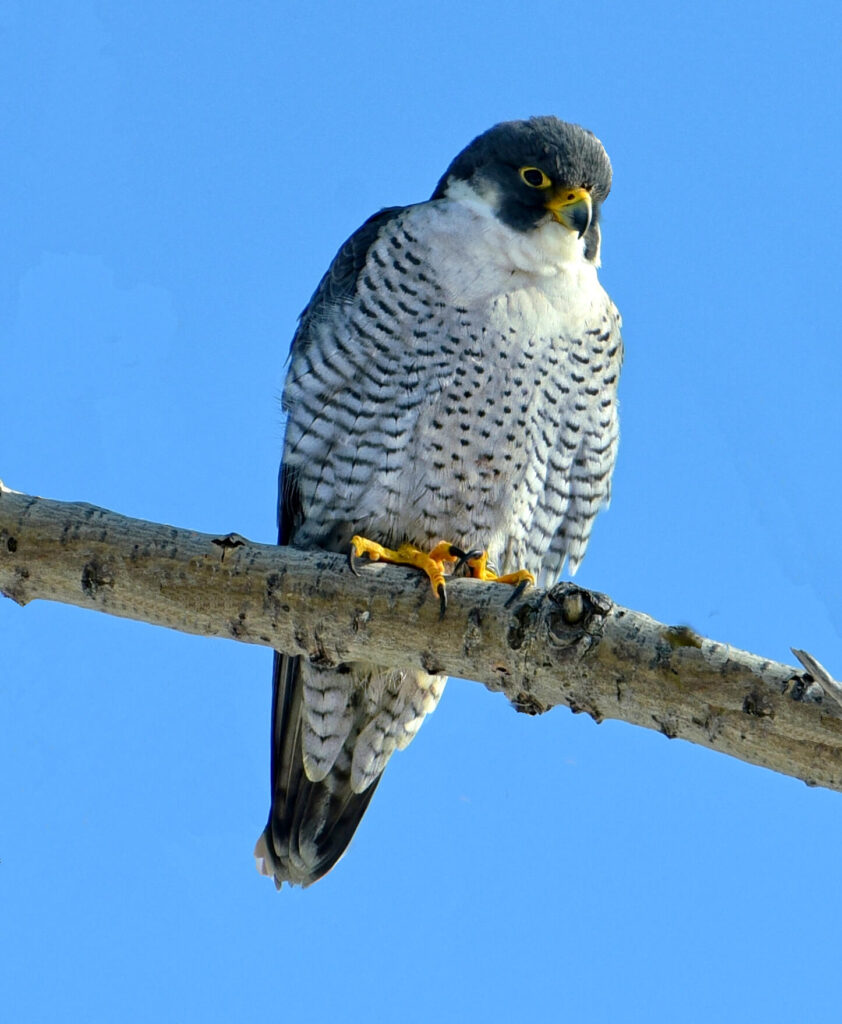
The peregrine falcon is at the top of our list. It is widely recognized as the fastest bird and animal in the world. This remarkable raptor can reach speeds of up to 389 km/h (242 mph). It achieves this during its hunting dive, known as a stoop.
Key features:
- Size: 34-58 cm in length
- Wingspan: 74-120 cm
- Weight: 330 g – 1.5 kg
- Distinctive blue-grey back and black head
- Global distribution, absent only in extreme polar regions, New Zealand, and most tropical rainforests
The peregrine falcon’s incredible speed is attributed to its aerodynamic body shape and powerful muscles. During its high-speed dive, it uses small bony tubercles on its nostrils. These tubercles direct intense airflow away. This adaptation allows the falcon to breathe more easily while maintaining its record-breaking velocity.
Peregrine falcons primarily hunt medium-sized birds but may also target small mammals, reptiles, and insects. They mate for life and typically nest on cliff faces or tall man-made structures.
2. Saker Falcon (Falco cherrug)
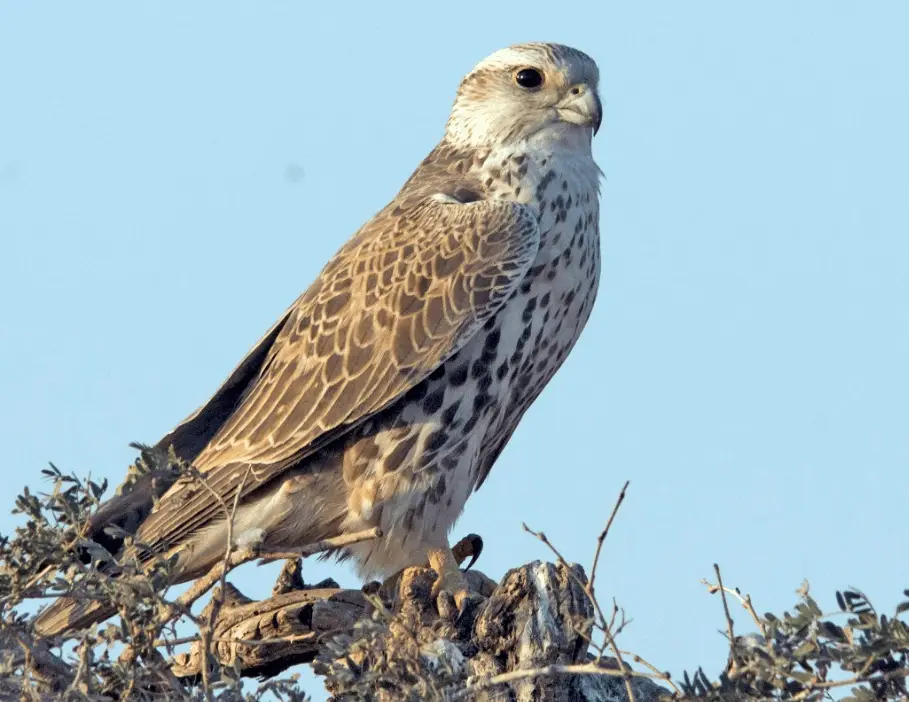
The saker falcon takes second place with a top speed of 325 km/h (202 mph). This large falcon species is found across the Palearctic region, from Central Europe to Manchuria.
Key features:
- Size: 45-57 cm in length
- Wingspan: 97-126 cm
- Weight: 730 g – 1.3 kg
- Variable plumage, often with streaked feathers
- national bird of Hungary, the United Arab Emirates, and Mongolia
Saker falcons prefer open grasslands with scattered trees or cliffs. Unlike the peregrine falcon, they typically hunt by pursuing prey horizontally rather than diving from great heights. Their diet consists mainly of rodents and birds, with a particular fondness for feral pigeons and ground-nesting squirrels in Europe.
These falcons face threats from illegal hunting and habitat loss, with an estimated population of only 7,200–8,000 individuals.
3. Golden Eagle (Aquila chrysaetos)
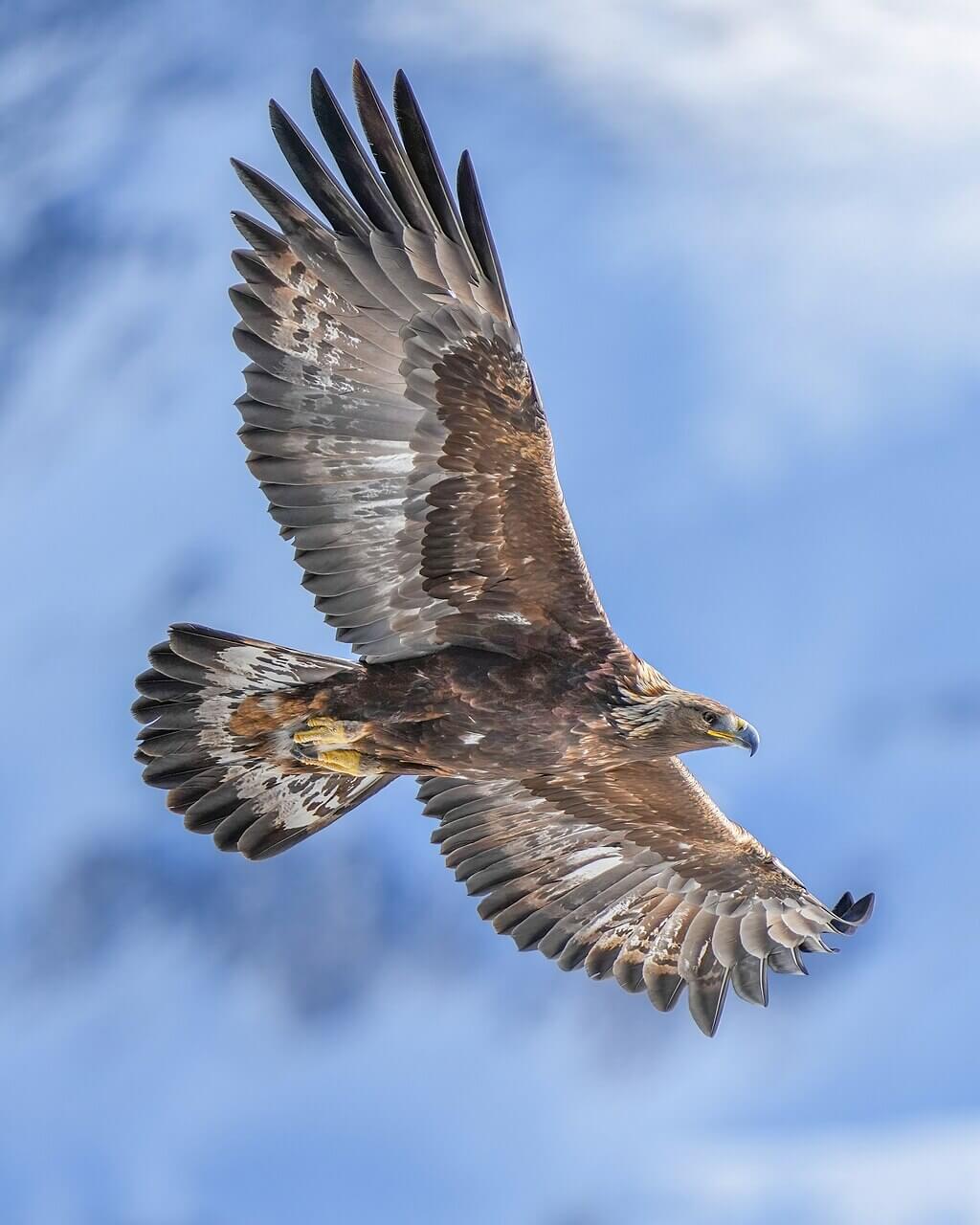
The golden eagle is one of the most widely distributed eagle species. It claims the third spot with a top speed of 321 km/h (200 mph).
Key features:
- Size: 66-102 cm in length
- Wingspan: 1.8-2.34 m
- Weight: 4.5-6.75 kg
- Dark brown body with lighter golden-brown nape
- Distinctive upturned V-shape of wings during flight
Golden eagles are revered as one of the best fliers among raptors. They possess large, broad wings with finger-like indentations at the tips. They are known for their agility and strength. These traits allow them to hunt a variety of prey, including hares, rabbits, marmots, and ground squirrels.
Golden eagles are monogamous and may mate for life. They build massive nests on cliffs or other elevated locations. They often return to the same nesting site for multiple breeding seasons.
4. Gyrfalcon (Falco rusticolus)
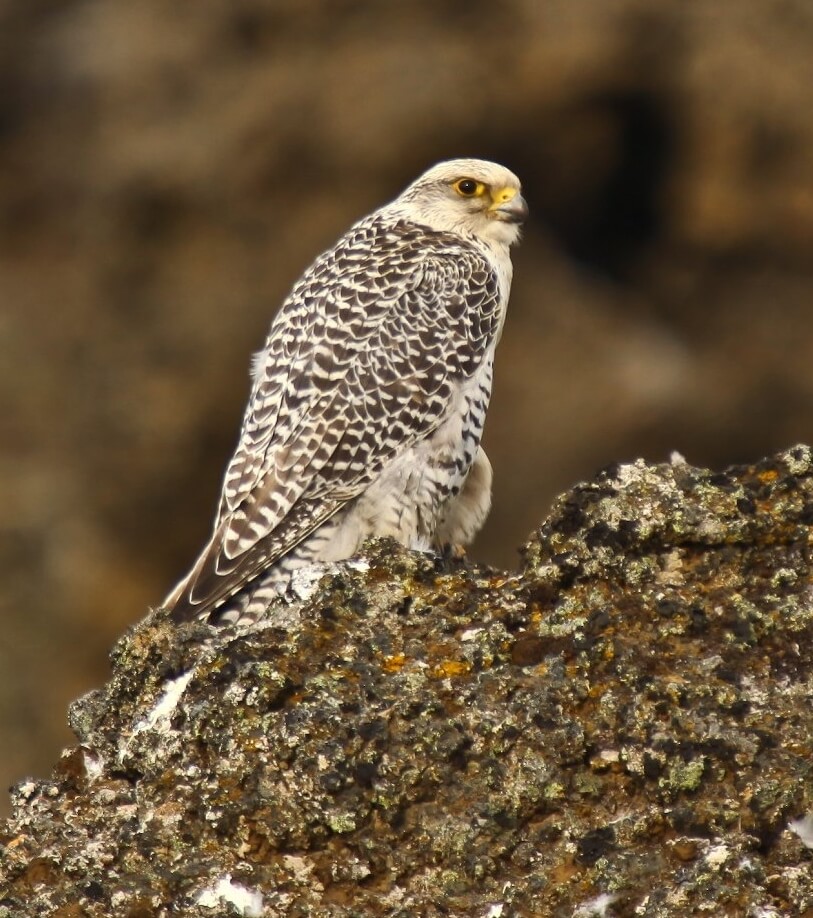
The gyrfalcon, the largest of all falcon species, reaches speeds between 186-209 km/h (116-130 mph).
Key features:
- Size: 48-65 cm in length
- Wingspan: 110-160 cm
- Weight: 850 g – 1.75 kg
- Highly variable plumage, ranging from white to dark morphs
- Sexual dimorphism, with females significantly larger than males
Gyrfalcons are adapted to hunt in flight, attacking horizontally rather than stooping from great heights. They primarily feed on birds and mammals, often forcing flying prey to land before making the kill on the ground.
These magnificent birds typically nest on cliff walls. They use abandoned nests of other species such as golden eagles or common ravens. Gyrfalcons have been prized as hunting birds for centuries due to their size and power.
5. White-throated Needletail (Hirundapus caudacutus)
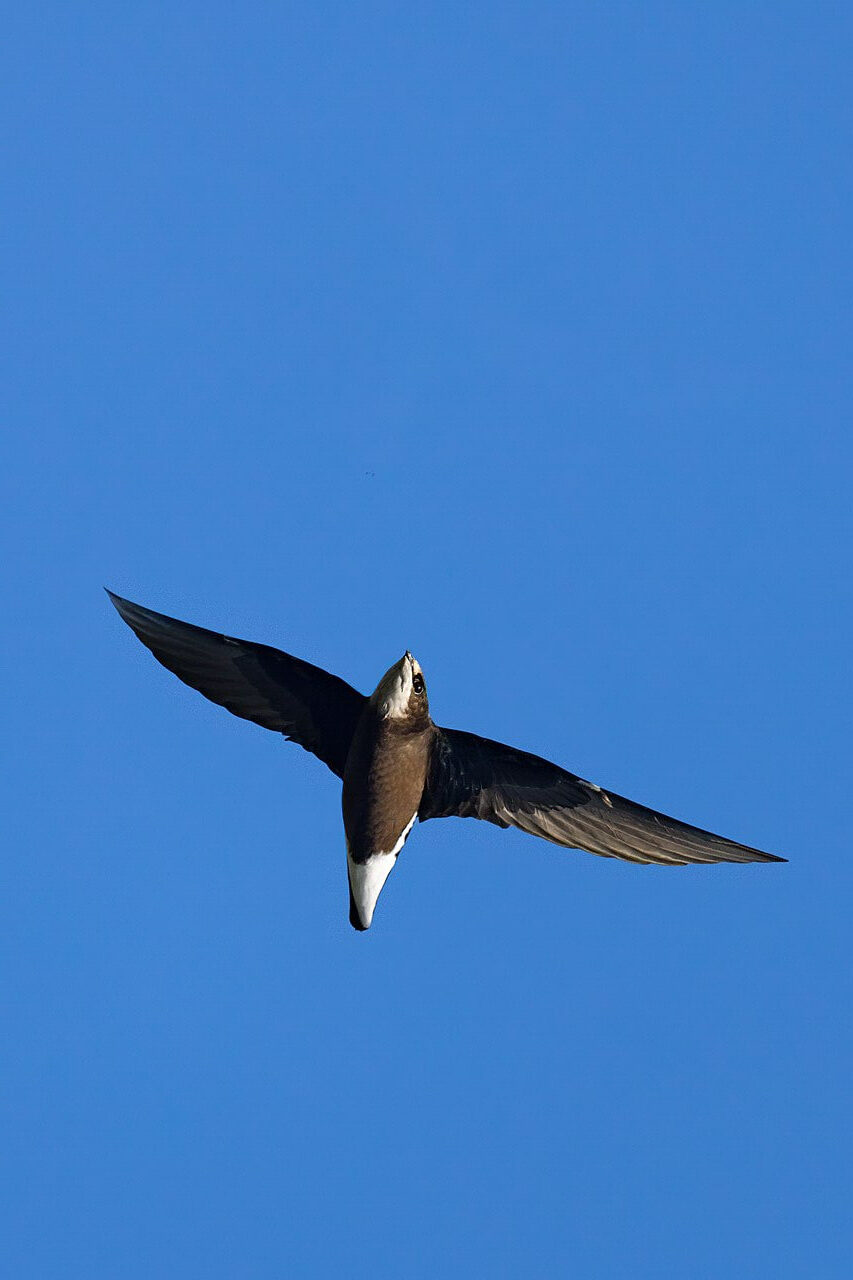
The White-throated Needletail (Hirundapus caudacutus) is a fast-flying bird known for its incredible speed and agility in the air. This swift is predominantly found in Asia and migrates to Australia during the non-breeding season.
It is easily recognizable by its white throat and underparts, contrasting with its dark upper body. Also known as the spine-tailed swift, the white-throated needletail can reach speeds of 168 km/h (105 mph).
Key features:
- Size: 18-20 cm in length
- Wingspan: 29-34 cm
- Weight: 100-120 g
- Grayish-brown body with white throat and flank patches
- Distinctive spine-tipped tail
These large swifts are migratory. They breed in southern Siberia and Central Asia. They winter in the Indian Subcontinent, Southeast Asia, and Australia. They are rarely spotted in Western Europe.
White-throated needletails spend most of their time in the air, feeding on flying insects such as moths, flies, and beetles. They nest in tree cavities or rock crevices in cliffs.
6. Common Swift (Apus apus)
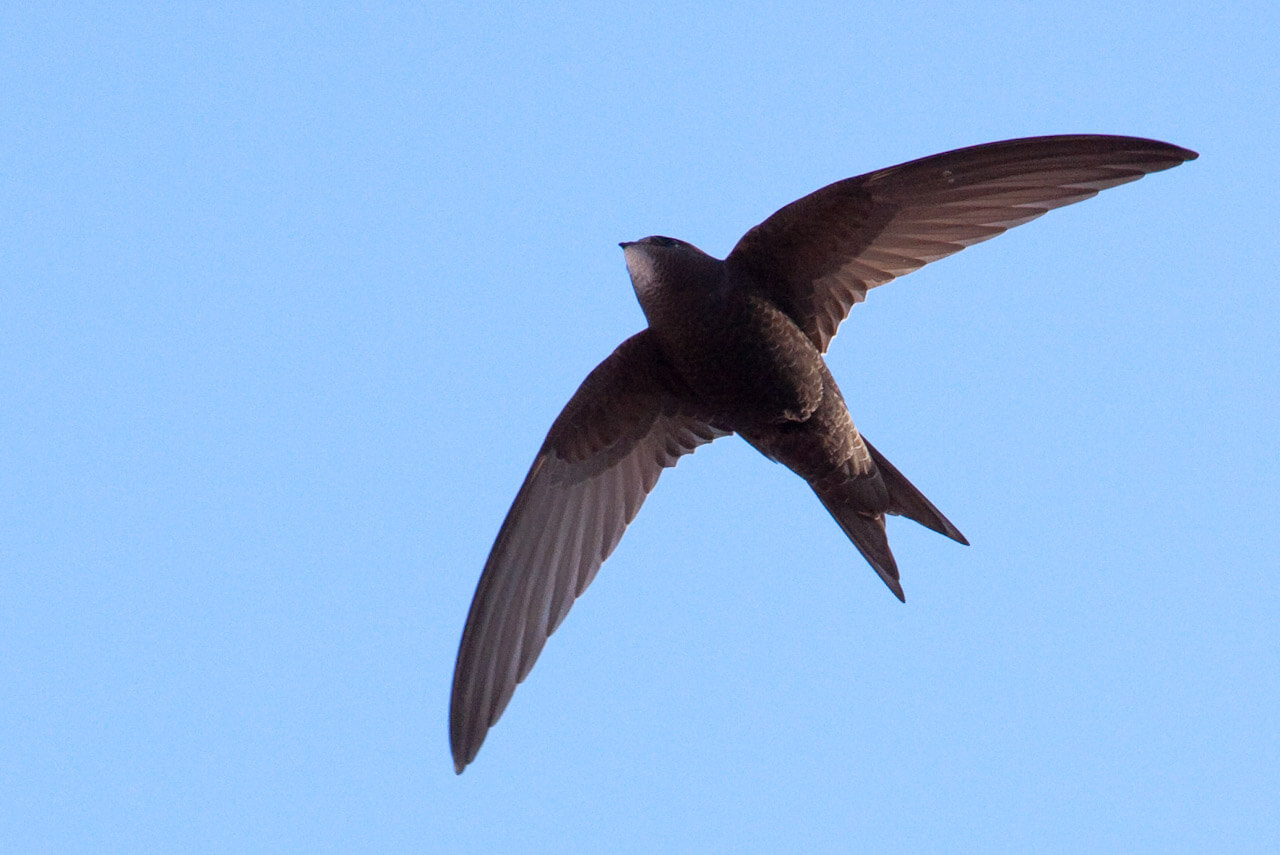
The common swift achieves speeds of up to 165 km/h (103 mph). This makes it one of the fastest birds in level flight.
Key features:
- Size: 16-17 cm in length
- Wingspan: 38-40 cm
- Appearance: Blackish-brown with a faint white chin spot
- Crescent or boomerang-shaped wings
Common swifts are remarkable for spending almost their entire lives in the air. They eat, drink, and even sleep on the wing, landing only to nest. Some individuals may stay airborne for up to ten months without landing.
These birds form lifelong pair bonds and often return to the same nesting sites year after year. Young swifts have a unique ability. They enter a torpid state when food is scarce. This lowers their body temperature and metabolism. These changes allow them to survive for several days without eating.
7. Eurasian Hobby (Falco subbuteo)

The Eurasian Hobby (Falco subbuteo) is a small, slender falcon known for its agile flight and swift hunting skills. This bird of prey is found across Europe, Asia, and parts of Africa, often inhabiting open woodlands and marshes. It primarily preys on insects and small birds, showcasing remarkable aerial acrobatics during its hunts.
Key features:
- Size: 29-36 cm in length
- Wingspan: 74-84 cm
- Weight: 175-285 g
- Slate-grey upperparts with streaked white underparts and rufous thighs
These agile hunters are known for their ability to catch large insects, such as dragonflies, in flight. They also prey on small birds and bats. Eurasian hobbies inhabit open areas like savannas, farmlands, and marshes. They often nest in old crow nests or other birds’ abandoned nests.
8. Magnificent Frigatebird (Fregata magnificens)

The largest species of frigatebird, the magnificent frigatebird, can reach speeds of 153 km/h (95 mph).
Key features:
- Size: 89-114 cm in length
- Wingspan: 2.17-2.44 m
- Weight: 1.1-1.5 kg
- Mainly black plumage with long, forked tails
- Males have a distinctive red gular pouch
Frigatebirds are known for their ability to soar for weeks on wind currents. They spend most of their day in the air, foraging for food and roosting at night on trees or cliffs. Their diet primarily consists of flying fish and squid.
Interestingly, frigatebirds are known as kleptoparasites, often stealing food from other seabirds and even taking seabird chicks from nests.
9. Spur-winged Goose (Plectropterus gambensis)
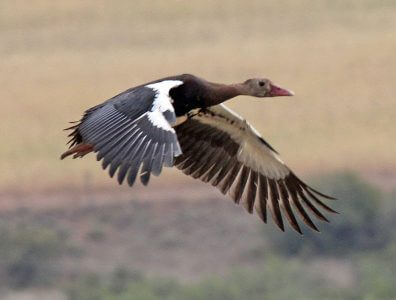
The Spur-winged Goose (Plectropterus gambensis) is a large waterfowl native to sub-Saharan Africa. It is notable for its distinctive spurs on the wings, which are used for defense. This bird typically inhabits wetlands and grasslands, feeding on a variety of vegetation and small aquatic animals. This large African waterbird can reach speeds of 143 km/h (89 mph).
Key features:
- Size: 75-115 cm in length
- Wingspan: 150-200 cm
- Weight: 4-6.8 kg
- Found in Sub-Saharan Africa
- Diet consists mainly of plant material, occasionally supplemented with small fish or insects
Spur-winged geese inhabit open grasslands near water bodies. They are social birds, often gathering in small flocks of up to 50 individuals. Interestingly, some populations of spur-winged geese can become toxic when their diet includes a large proportion of blister beetles.
10. Red-breasted Merganser (Mergus serrator)
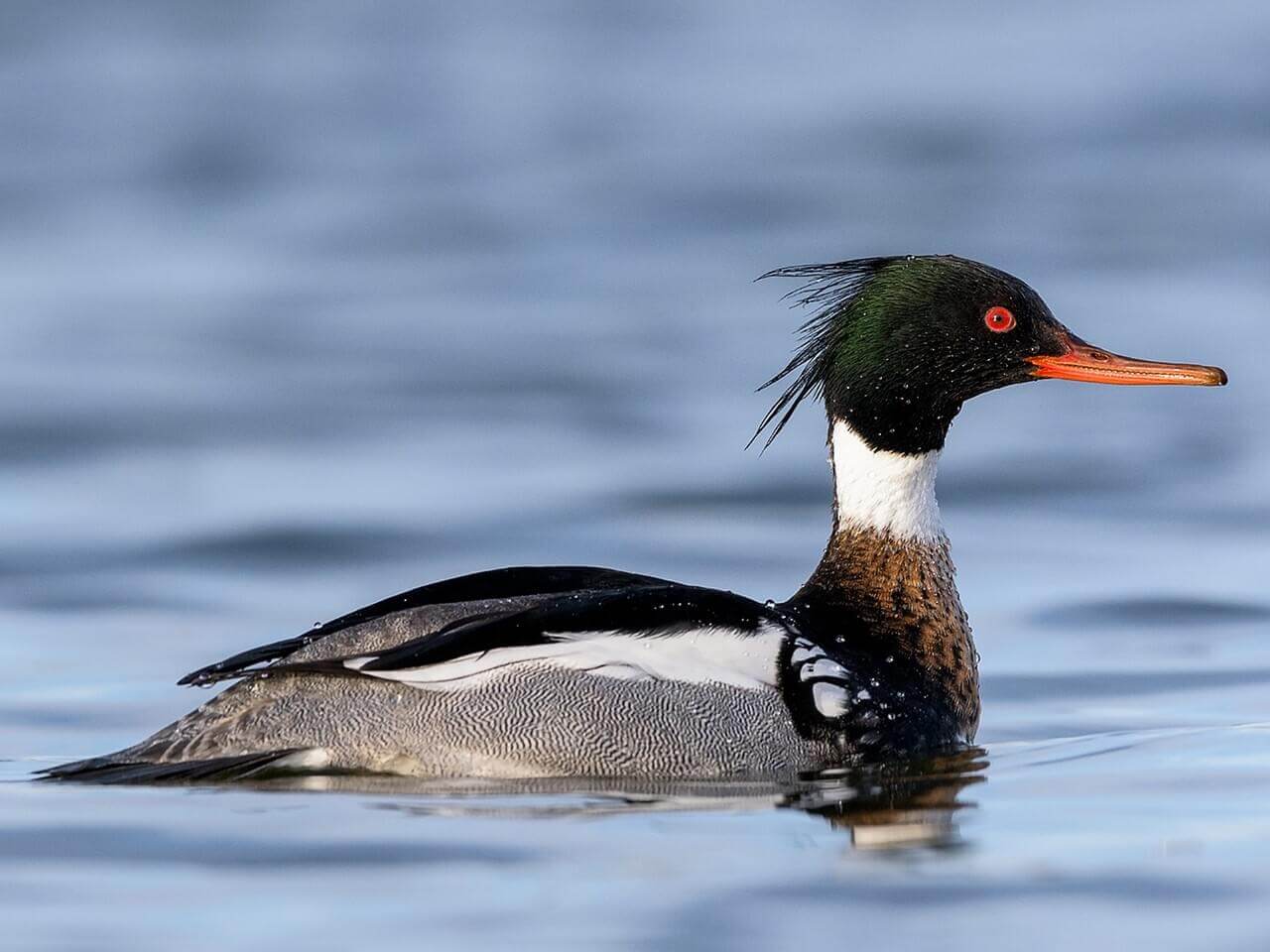
The Red-breasted Merganser (Mergus serrator) is a striking diving duck. It is known for its distinctive red breast and spiky crest. It has a flight speed of 130 km/h (81 mph). Found across North America, Europe, and Asia, it typically inhabits coastal waters, lakes, and rivers. This bird is an adept swimmer and diver, feeding primarily on fish and aquatic invertebrates.
Key features:
- Size: 51-64 cm in length
- Wingspan: 66-74 cm
- Weight: 800-1350 g
- Long, thin red bill with serrated edges
- Distinctive spikey crest
These ducks are found in the Northern Hemisphere and are known for their fast flight and diving abilities. They hunt by diving from the surface to pursue aquatic prey underwater, using their hooked bills to catch slippery fish.
Red-breasted mergansers migrate annually from lake and river breeding areas to coastal wintering grounds. They form small flocks of up to 100 birds outside of the breeding season.
Frequently Asked Questions
What is the fastest bird in the world?
The peregrine falcon is considered the fastest bird in the world, capable of reaching speeds up to 389 km/h (242 mph) during its hunting dive or stoop.
How do scientists measure the speed of flying birds?
Scientists use various methods to measure bird flight speeds, including radar tracking, GPS devices, and high-speed cameras. For some species, like the peregrine falcon, speeds are often recorded during controlled falconry exercises.
Why are some birds faster than others?
Birds’ flight speeds are influenced by factors such as body shape, wing structure, muscle strength, and ecological niche. Birds of prey and those that hunt in flight often evolve to be faster than species that don’t rely on speed for survival.
Do all fast-flying birds migrate?
Not all fast-flying birds are migratory, but many are. Species like the common swift and white-throated needletail are long-distance migrants, while others like the peregrine falcon may be partially migratory depending on their habitat.
Are there any conservation concerns for these fast-flying birds?
Yes, several species on this list face conservation challenges. The saker falcon, for example, is threatened by illegal hunting and habitat loss. The peregrine falcon population was once severely affected by pesticide use but has since recovered in many areas thanks to conservation efforts.
Final words on the fastest flying Birds in the world
The world of fast-flying birds is diverse and fascinating, showcasing nature’s incredible adaptations for life in the skies. The record-breaking peregrine falcon demonstrates one aspect of avian flight capabilities. The constantly airborne common swift exhibits another. These birds showcase the remarkable variety in avian flight.
As we continue to study and appreciate these magnificent creatures, we must support conservation efforts. This support ensures their survival for future generations to witness and admire.
References
- Cornell Lab of Ornithology. (n.d.). Peregrine Falcon. Retrieved from All About Birds.
- National Geographic. (n.d.). Golden Eagle. Retrieved from National Geographic.
- Audubon Society. (n.d.). Gyrfalcon. Retrieved from Audubon.
- RSPB. (n.d.). Common Swift. Retrieved from RSPB.
- The fastest birds in the world – Top 10. Retrieved from TreeHugger.
- Fastest Birds – Birds by Flight Speed. Retrieved from The Travel Almanac.
- The fastest birds in the world – Top 10. Retrieved from Dino Animals.
- Peregrine Falcon. Retrieved from Defenders of Wildlife.
- Swift. Retrieved from Encyclopædia Britannica.
- Fastest bird – level flight. Retrieved from Guinness World Records.


